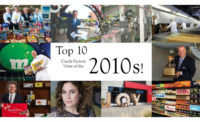 It’s a great time to be in the snack bar business, nobody denies that. It’s hard to argue with the fact that the U.S. market has more than doubled to almost $6 billion over the last decade.
It’s a great time to be in the snack bar business, nobody denies that. It’s hard to argue with the fact that the U.S. market has more than doubled to almost $6 billion over the last decade.
Unfortunately for the confectionery industry, it’s not as easy as it might look to enter the category.
Rabobank Group, a global financial services provider, has released a new report about the snack bar sector, and claims few confectionery companies found success in extending their candy brands into the snack bar space.
The finding suggests there is a line between snack bars and candy that’s hard to cross.
"Candy is perhaps too much of a challenge to the wholesome, active image of the snack bar, particularly energy bars,” says Nicholas Fereday, author of the report and Rabobank analyst. “Snack bars are perceived as contributing to better health and, up until now, have been less associated with the empty calories of soft drinks and candy."
But the market is far from saturated, and there’s still plenty of potential for any company looking to tap into the category.
Consumers love snack bars because of their multi-purpose appeal, convenience and broad retail distribution. And they especially like energy and nutrition bars, which Rabobank estimates account for more than one-third of sales, and grew at a 9% CAGR between 2007 and 2012.
"Snack bars are one of the few bright spots in today's U.S. processed food market," says Fereday. "[They] have found broad appeal among a large consumer base that ranges from athletes to couch potatoes, from working mothers to professionals on the go.”
Leading the pack is Clif Bar & Co., General Mills and Kellogg's. The three companies make up almost 60% of the market and boast seven of the top ten brands.
General Mills alone owns about one-quarter of the market, and its high profile campaign to improve nutritional content has led to strong growth of its Nature Valley, Betty Crocker, Fiber One, and Larabar brands.
And Kellogg's, the leading category brand, has successfully expanded its iconic breakfast brands — Kashi, Rice Krispies, Nutri-grain, and Special K — across multiple snack bar formats.
Meanwhile, the 20-year old Clif Bar & Co.rarely advertises in mainstream media, preferring to rely on sports sponsorships, social media and word-of-mouth to secure its lead in the energy bar segment with its brands: Clif, Luna and Mojo.
Lucky for any company trying to tap the snack bar market, four main factors will likely drive the sector’s continued growth, Rabobank says:
1. Persistent consumer trends toward greater convenience, portability, and health/wellness show no signs of waning — particularly good news for the energy and nutrition and breakfast bars.
2. A la Kellogg's, there is huge potential for companies to expand their strong brands from the wider food and snack categories into the snack bar segment.
3. As the food service industry takes a larger slice of the consumer food dollar, there is strong opportunity for partnership with quick service restaurant companies seeking to open up new day parts to boost sales.
4. Like the humble potato chip, snack bars are an excellent platform to launch new flavors and functional food ingredients.





